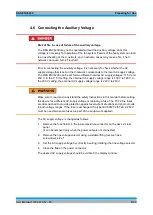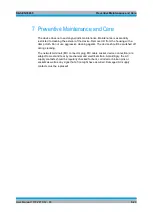
R&S ENV4200
Operating the V-Network
User Manual 1107.2470.12 - 03
E-24
5
Operating the V-Network
The V-network is not fused in the three-phase circuit. The user must ensure that the
operating circuit between the power supply and the power connector of the V-network
is fused correctly (see also chapter AC Supply).
When the R&S ENV4200 is operated, make sure that the air supply from above and
below and from the side is not obstructed. The device may not be operated
unsupervised and must be placed on a nonflammable base (e.g. metal plate) in order
to prevent a fire if the ventilation system fails.
Whenever the V-network is put into operation, check the correct functioning of the fans
by pressing the fan button. This is required to prevent any damage due to overheating.
The ventilation of the V-network is automatically set to full fan speed at an internal
housing temperature of approx. 50 °C, and the fan LED is illuminated in orange when
the auxiliary voltage is connected to the mains. If the coil temperature is > 100 °C, an
acoustic alarm sounds and the fan LED turns red.
In case of a high constant current load, the temperature of the connection elements
and the connection lines must be checked from time to time.
If the audible fan alarm sounds and the fan LED turns red, immediately disconnect the
V-network from the test load. The surface of the device can seriously overheat,
causing a risk of burns. If this happens, the device must undergo servicing and be
repaired if necessary.
5.1 Measurement Example
shows the test setup for measuring disturbance voltages on a hand drill. The
artificial hand must be connected for this type of EUT. Three metal foils are arranged
on the hand drill and connected to the artificial hand (ARTIFICIAL HAND).







































